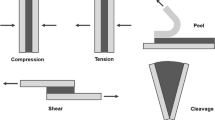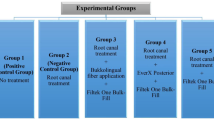Abstract
Since a direct comparison of composites efficacy in clinical studies is very difficult, our study aimed to analyse in laboratory tests under standardised and simulated clinical conditions a large variety of commercial composite materials belonging to eight different materials categories. Thus, 72 hybrid, nano-hybrid, micro-filled, packable, ormocer-based and flowable composites, compomers and flowable compomers were compared in terms of their mechanical behaviour. Flexural strength (FS), flexural modulus (FM), diametric tensile (DTS) and compressive strength (CS) were measured after the samples had been stored in water for 24 h at 37°C. Results were statistically analysed using one-way ANOVA with Tukey HSD post hoc test (α = 0.05) as well as partial η 2 statistics. Large varieties between the tested materials within the same material category were found. The hybrid, nano-hybrid, packable and ormocer-based composites do not differ significantly among each other as a material type, reaching the highest FS values. Nano-hybrid composites are characterised by a good FS, the best DTS but a low FM. The lowest mechanical properties achieved the micro-filled hybrids. The flowable composites and compomers showed for all properties comparable result. Both flowable material categories do not differ significantly from the micro-filled composites for the most mechanical properties, showing only a higher DTS. The filler volume was shown to have the highest influence on the measured properties, inducing a maximum FS and FM at a level of 60%, whereas such dependence was not measured for DTS or CS. The influence of the type of material on the mechanical properties was significant but very low, showing the strongest influence on the CS.

Similar content being viewed by others
Reference
Braga RR Ferracane JL (2004) Alternatives in polymerisation contraction stress management. Crit Rev Oral Biol Med 15:176–184
Ferracane JL (1995) Current trends in dental composites. Crit Rev Oral Biol Med 6:302–318
Rueggeberg FA (2002) From vulcanite to vinyl, a history of resins in restorative dentistry. J Prosthet Dent 87:364–379
Weinmann W, Thalacker C Guggenberger R (2005) Siloranes in dental composites. Dent Mater 21:68–74
Bayne SC, Heymann HO, Swift EL (1994) Update on dental composite restorations. I Am Dent Assoc 125:687–701
Hickel R, Dasch W, Janda R, Tyas M, Anusavice K (1998) New direct restorative materials. FDI Commission Project. Int Dent J 48:3–16
Lutz F, Phillips RW (1983) A classification and evaluation of composite resin systems. J Prosthet Dent 50:480–488
Willems G, Lambrechts P, Braem M, Celis JP, Vanherle G (1992) A classification of dental composites according to their morphological and mechanical characteristics. Dent Mater 8:310–319
Epanechnikov VA (1969) Nonparametric estimation of a multivariate probability density. Theory Probab App 14:153–458
Sarrett DC (2005) Clinical challenges and the relevance of materials testing for posterior composite restorations. Dent Mater 21:9–20
Brunthaler A, Konig F, Lucas T, Sperr W, Schedle A (2003) Longevity of direct resin composite restorations in posterior teeth. Clin Oral Investig 7:63–70
van Dijken JW (2000) Direct resin composite inlays/onlays: an 11 year follow-up. J Dent 28:299–306
Van Nieuwenhuysen JP, D′Hoore W, Carvalho J, Qvist V (2003) Long-term evaluation of extensive restorations in permanent teeth. J Dent 31:395–405
Lambrechts P, Ameye C, Vanherle G (1982) Conventional and micro-filled composite resins. Part II. Chip fractures. J Prosthet Dent 48:527–538
Leinfelder KF, McCartha CD, Wisniewski JF (1985) Posterior composite resins. A critical review. J Ala Dent Assoc 69:19–25
Zantner C, Kielbassa AM, Martus P, Kunzelmann KH (2004) Sliding wear of 19 commercially available composites and compomers. Dent Mater 20:277–285
Ferracane JL (2006) Is the wear of dental composites still a clinical concern? Is there still a need for in vitro wear simulating devices. Dent Mater 22:689–692
Curtis AR, Shortall AC, Marquis PM, Palin WM (2008) Water uptake and strength characteristics of a nano-filled resin-based composite. J Dent 36:186–193
Manhart J, Kunzelmann KH, Chen HY, Hickel R (2000) Mechanical properties and wear behaviour of light-cured packable composite resins. Dent Mater 16:33–40
Choi KK, Ferracane JL, Hilton TJ, Charlton D (2000) Properties of packable dental composites. J Esthet Dent 12:216–226
Knobloch LA, Kerby RE, Seghi R, Berlin JS, Clelland N (2002) Fracture toughness of packable and conventional composite materials. J Prosthet Dent 88:307–313
Klein F, Keller AK, Staehle HJ, Dorfer CE (2002) Proximal contact formation with different restorative materials and techniques. Am J Dent 15:232–235
Peumans M, Van Meerbeek B, Asscherickx K, Simon S, Abe Y, Lambrechts P, Vanherle G (2001) Do condensable composites help to achieve better proximal contacts. Dent Mater 17:533–541
Ernst CP, Buhtz C, Rissing C, Willershausen B (2002) Clinical performance of resin composite restorations after 2 years. Compend Contin Educ Dent 23:7117–7720
Ernst CP, Canbek K, Aksogan K, Willershausen B (2003) Two-year clinical performance of a packable posterior composite with and without a flowable composite liner. Clin Oral Investig 7:129–134
Lopes LG, Cefaly DF, Franco EB, Mondelli RF, Lauris JR, Navarro MF (2003) Clinical evaluation of two “packable” posterior composite resins: two-year results. Clin Oral Investig 7:123–128
Poon EC, Smales RJ, Yip KH (2005) Clinical evaluation of packable and conventional hybrid posterior resin-based composites: results at 3.5 years. J Am Dent Assoc 136:1533–1540
Wolter H, Storch W, Ott H (1994) New inorganic/organic copolymers (ORMOCER®S) for dental applications. Mat ResSoc Symp Proc 346:143–149
Tagtekin DA, Yanikoglu FC, Bozkurt FO, Kologlu B, Sur H (2004) Selected characteristics of an Ormocer and a conventional hybrid resin composite. Dent Mater 20:487–497
Yap AU, Tan CH, Chung SM (2004) Wear behaviour of new composite restoratives. Oper Dent 29:269–274
Cattani-Lorente M, Bouillaguet S, Godin CH, Meyer JM (2001) Polymerization shrinkage of Ormocer based dental restorative composites. Eur Cell Mater 1:25–26
Moszner N, Gianasmidis A, Klapdohr S, Fischer UK, Rheinberger V (2008) Sol-gel materials 2. Light-curing dental composites based on ormocers of cross-linking alkoxysilane methacrylates and further nano-components. Dent Mater 24:851–856
el Kalla IH, Garcia-Godoy F (2000) Compomers adaptation to class I and V cavities in permanent teeth. ASDC J Dent Child 67(8):29–36
Yap AU, Chung SM, Chow WS, Tsai KT, Lim CT (2004) Fracture resistance of compomer and composite restoratives. Oper Dent 29:29–34
Ferracane JL, Antonio RC, Matsumoto H (1987) Variables affecting the fracture toughness of dental composites. J Dent Res 66:1140–1145
Wucher M, Grobler SR, Senekal PJ (2002) A 3-year clinical evaluation of a compomer, a composite and a compomer/composite (sandwich) in class II restorations. Am J Dent 15:274–278
Roeters JJ, Frankenmolen F, Burgersdijk RC, Peters TC (1998) Clinical evaluation of Dyract in primary molars: 3-year results. Am J Dent 11:143–148
Benz C, Hickel R (2005) 4-year evaluation of a compomer in class II restorations. Dtsch Zahnärztl Z 60:200–202
Huth KC, Manhart J, Selbertinger A, Paschos E, Kaaden C, Kunzelmann KH, Hickel R (2004) 4-year clinical performance and survival analysis of Class I and II compomer restorations in permanent teeth. Am J Dent 17:51–55
Chen HY, Manhart J, Kunzelmann KH, Hickel R (2003) Polymerization contraction stress in light-cured compomer restorative materials. Dent Mater 19:597–602
Htang A, Ohsawa M, Matsumoto H (1995) Fatigue resistance of composite restorations: effect of filler content. Dent Mater 11:7–13
Conflict of interest
The authors declare that they have no conflict of interest.
Author information
Authors and Affiliations
Corresponding author
Additional information
An erratum to this article can be found at http://dx.doi.org/10.1007/s00784-009-0274-4
Rights and permissions
About this article
Cite this article
Ilie, N., Hickel, R. Investigations on mechanical behaviour of dental composites. Clin Oral Invest 13, 427–438 (2009). https://doi.org/10.1007/s00784-009-0258-4
Received:
Revised:
Accepted:
Published:
Issue Date:
DOI: https://doi.org/10.1007/s00784-009-0258-4




